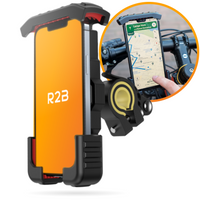No Products in the Cart
Known for their wide tires and rugged appearance, fat bikes have become extremely popular on both public roads and rough terrain. But with the increase in the number of fat bikes, especially the electric variants, the question arises: is wearing a helmet mandatory on a fat bike? In this blog we discuss the current regulations regarding mandatory helmet use on a fat bike, the differences between various types of electric bicycles, and we provide practical safety tips. We also present our choice for the best bicycle helmet and indispensable e-bike accessories. Safe driving starts with the right equipment and adhering to the rules.
Table of contents
The current regulations regarding the helmet requirement for fat bikes are clear: a helmet is mandatory for souped-up fat bikes and fat bikes that travel faster than 25 kilometers per hour. This also applies to speed pedelecs and electric fat bikes, which fall under the same rules as mopeds. Wearing a helmet is currently not mandatory for a regular electric bicycle, but Veilig Verkeer Nederland strongly recommends it to prevent serious head injuries. Fat bikes with an electric motor that remain below the limit of 25 kilometers per hour also fall under the same rules as mopeds, where a blue license plate and a helmet are mandatory. It is important that your fat bike complies with the rules, otherwise you risk fines and other sanctions. Cyclists on Dutch cycle paths must also take these rules into account to ensure the safety of all road users.
Electric bicycles come in different types and with varying capacities. A regular electric bicycle offers pedal assistance up to 25 kilometers per hour and does not require a driver's license or helmet. Electric fat bikes, with their fat tires and robust construction, can ride on the bike path as well as on rough terrain. A speed pedelec, on the other hand, can reach speeds of up to 45 kilometers per hour and requires both a driver's license and a helmet. Supercharged fat bikes, which are outside the legal power and speed limits, are considered mopeds and must follow the same rules, including wearing a helmet and a license plate. The choice of an electric bicycle depends on your usage needs, such as maximum speed, motor power, and the regulations you want to comply with. Safe Traffic Netherlands emphasizes the importance of these rules for the safety of e-bike riders and other road users.
Using electric bicycles and e-bikes offers many benefits, but also involves some safety risks. To ensure your own safety and that of others, it is important to take some precautions. Below you will find practical tips for riding safely on your electric bicycle or e-bike:
Always wear a bicycle helmet: Even if it is not mandatory, a helmet can prevent fatal injuries in accidents.
Check legal requirements: Make sure your electric bike meets regulations, such as having a correct license plate and no throttle for certain models.
Insure your bike: Good insurance covers any damage and offers peace of mind.
Maintain your bike regularly: Check the condition of the fat tires and other parts to ensure optimal grip and safety.
Stick to the speed limit: Avoid souped-up, non-compliant fat bikes to avoid fines and risks.
Be alert on cycle paths: Take other road users into account and respect the traffic rules to avoid accidents.
By following these tips, you can safely enjoy your rides on Dutch cycle paths and other roads. Veilig Verkeer Nederland emphasizes that conscious and careful e-bikers contribute to safer traffic for everyone.
Our R2B bicycle helmet is the perfect choice for any electric fat bike rider. With its LED lighting you are extra visible on the road, which significantly increases your safety. This helmet is not only comfortable and stylish, but also meets the highest safety standards, ideal for electric bicycles and e-bikes, but also for regular bicycles. Moreover, it is versatile enough to also be used as a skate or inline skate helmet. Choose the R2B bicycle helmet and ride your fat bike with confidence and safety.
In addition to a good bicycle helmet, there are other indispensable accessories that make your e-bike experience safer and more comfortable. For example, consider a sturdy phone holder for the bicycle , so that you always have your navigation at hand without endangering your safety. A reliable bicycle lock is essential to protect your e-bike against theft. Don't forget a decent bicycle pump for properly inflated tires and a comfortable bicycle saddle for longer rides. View R2B's full bicycle accessories page to view a wide range of must-have bicycle accessories . With these accessories you are fully equipped for every ride!
So, is there a fat bike helmet requirement? Yes, helmets are mandatory for a souped-up fat bike or a fat bike that travels faster than 25 kilometers per hour, comparable to the rules for speed pedelecs. Regular electric bicycles and fat bikes that operate below this speed do not require a helmet, although Veilig Verkeer Nederland strongly recommends it to prevent serious head injuries. Electric bicycles come in different types and power ratings, each with their own rules and safety requirements. Ensure your own safety when riding a fat bike by wearing a bicycle helmet, checking legal requirements, and properly maintaining your bicycle. With the right equipment and precautions, you can enjoy your rides on Dutch cycle paths and roads safely and with confidence.

